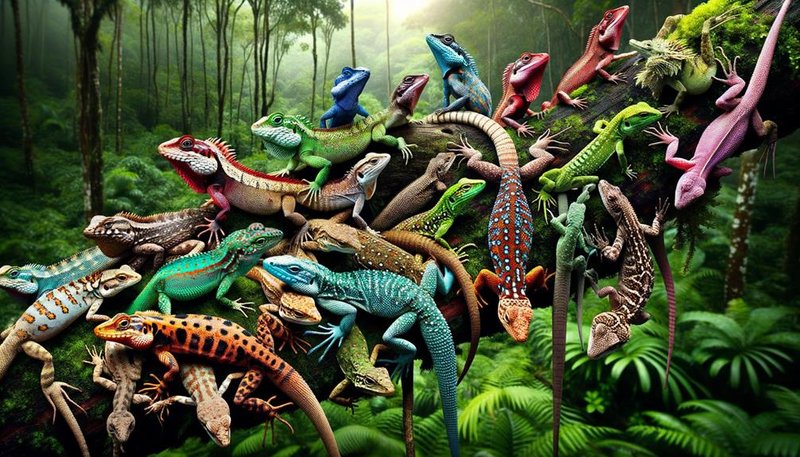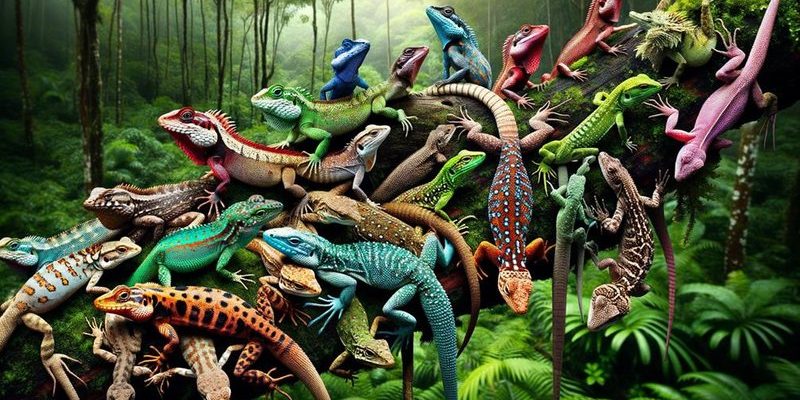
You might be surprised to learn that lizards belong to a larger group known as squamates, which also includes snakes. This means that while they’re often thought of as separate species, lizards and snakes share a lot of evolutionary history. Picture a game of evolution, where each player adapts to their surroundings in unique ways. The lizard’s story is one of survival, adaptation, and diversity that showcases nature’s incredible creativity.
Early Origins of Lizards
The story of lizards begins long before they roamed the Earth. The first reptiles appeared about 300 million years ago during the Carboniferous period. These early reptiles were primitive and quite different from the lizards we know today. They evolved from amphibian-like ancestors that had begun to adapt to life on land. This transition was vital; it allowed them to escape aquatic predators and explore new habitats.
As time went on, these early reptiles started to diversify. By the Mesozoic era, about 250 million years ago, lizards began to emerge. The earliest lizard-like reptiles were small, nimble creatures that scurried around, much like their modern descendants. They had to adapt to various environments, which led to some exciting developments in their physical features.
Some of these adaptations included changes in body shape, limbs, and scales. These changes helped lizards to thrive in different habitats, from dense forests to arid deserts. The variety we see today is a direct result of millions of years of evolution, making lizards a fascinating subject of study.
The Age of the Dinosaurs
During the Mesozoic era, which lasted from about 252 to 66 million years ago, lizards witnessed a fantastic explosion of diversity. This era is famously known as the Age of Dinosaurs, but it was also a golden age for reptiles, including lizards. Many lizard ancestors roamed the Earth alongside massive dinosaurs, adapting in ways that helped them survive in a world dominated by these giants.
Some lizard-like reptiles developed roles similar to those of modern-day monitor lizards, while others ventured into more specialized niches. For instance, some evolved longer bodies and limbs, while others grew to be extremely small and agile. This adaptability was crucial during this time, as it allowed them to find food and evade predators.
Interestingly, at this time, some lizards developed the ability to glide. The adaptations of these creatures varied greatly, leading to distinct evolutionary paths. Gliding lizards would leap from trees, using their elongated bodies and skin flaps to catch air, a skill that still exists in some modern species.
Surviving Extinction Events
Lizards faced significant challenges during their evolutionary history, especially with mass extinction events. The most famous of these was the one that wiped out the dinosaurs around 66 million years ago. This event, believed to be caused by a massive asteroid impact, drastically changed the Earth’s landscape and environment.
While many species went extinct, lizards managed to survive. Here’s the thing: their small size and diverse diets gave them an advantage. They could thrive in various environments and consume a wide range of food, including insects, plants, and smaller animals. This adaptability allowed them to bounce back and repopulate once the dust settled.
After the extinction, lizards began to fill the ecological niches left vacant by the dinosaurs. As mammals and birds emerged, lizards adapted to coexist with these new competitors. Their ability to thrive in diverse habitats became even more crucial during this time.
Modern Diversity of Lizards
Fast forward to today, and lizards have evolved into over 6,000 different species, showcasing incredible diversity in size, color, and behavior. From the tiny, colorful anole to the massive Komodo dragon, lizards exhibit a wide range of adaptations.
Some might ask, “How did they become so varied?” Well, the answer lies in their environments. Different habitats call for different survival strategies. For example, chameleons developed their color-changing abilities for camouflage and communication, while desert lizards adapted to store water and regulate their temperature.
Lizards are also fascinating due to their unique behaviors. Some species can even regenerate their tails if lost to predators. This skill is not just a cool party trick; it’s a survival mechanism that gives them a second chance at escaping danger.
Unique Adaptations and Features
What makes lizards stand out, besides their adaptability and diversity, are their unique features and behaviors. Take the gecko, for example. These little guys have specialized toe pads that allow them to climb almost any surface, including smooth glass. Their ability to stick to surfaces is due to tiny hairs on their feet that create molecular attractions with surfaces.
Another fascinating example is the Iguana, which has adapted to a herbivorous diet. Their strong jaws and specialized teeth allow them to consume tough plant material, showcasing how lizards have evolved to fill various ecological roles.
Some lizards, like the horned toad, can shoot blood from their eyes as a defense mechanism. This bizarre but effective strategy helps deter predators, giving the lizard a chance to escape. These are just a few examples of how lizards have adapted over time.
The Future of Lizards
As we look ahead, the future of lizards is uncertain. Habitat destruction, climate change, and pollution pose significant threats to many lizard species. Some scientists estimate that up to one-fifth of all lizard species may be at risk of extinction in the coming decades.
Efforts are underway to study and protect these amazing creatures. Conservation programs aim to preserve their habitats and ensure they continue to thrive. Here’s the thing: understanding the evolutionary history of lizards not only sheds light on their past but also highlights the importance of protecting them for the future.
By appreciating their journey through time, we can better understand how to protect the diverse species that exist today. Each lizard is like a living piece of history, showcasing millions of years of survival and adaptation.
The evolutionary history of lizards is a remarkable tale of resilience and adaptability. From their early beginnings as small reptiles to their incredible diversity today, lizards continue to thrive in a variety of habitats. Each species tells a story of survival against the odds, showcasing nature’s ability to innovate.
As we move forward, it’s essential to recognize the challenges lizards face and the need for conservation efforts to protect them. The next time you see a lizard basking in the sun or darting across your yard, remember the rich history behind it. They are not just reptiles; they are living links to the past, continually evolving as they navigate the world around them.

